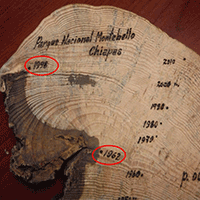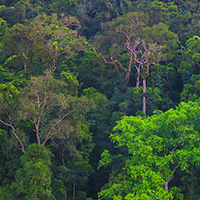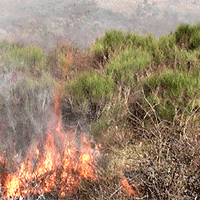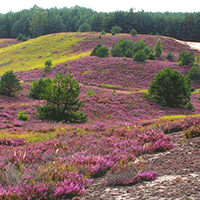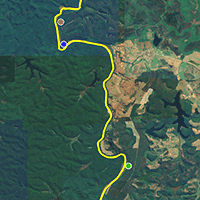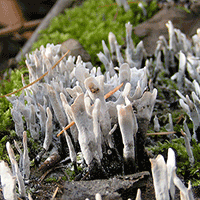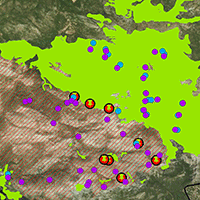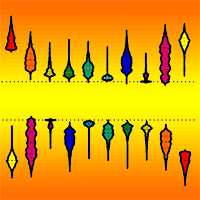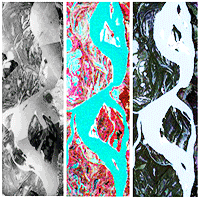
Changes in forest diversity over a chronosequence of fluvial islands
Federico Brumnich (1-2) , Zuleica Yael Marchetti (1-2), María Soledad Pereira (2)
iForest - Biogeosciences and Forestry, Volume 12, Issue 3, Pages 306-316 (2019)
doi: https://doi.org/10.3832/ifor2737-012
Published: Jun 06, 2019 - Copyright © 2019 SISEF
Research Articles
Abstract
The high environmental heterogeneity of large fluvial systems is reflected by the co-existence of contrasting plant communities and landforms. The main objective of this study was to assess the forest diversity changes in islands of the Middle Paraná River (Argentina) in order to discuss an integrative question: how synchronized are the major changes in the features of islands and forests? Persistence age, elevation and flood regime of 11 main channel islands were determined. Variables related to the vascular plant community and the tree stand structure of forests were also measured in 400 m2 plots. Islands were classified as young or old (YIs or OIs), according to their persistence age, which ranged from two to 108 years. Both island classes differed in their elevation but not in the proportion of low water phase. Only three out of nine tree species were dominant: Tessaria integrifolia and Croton urucurana (restricted to YIs and OIs, respectively), and Salix humboldtiana (distributed in both island classes). Alpha diversity was positively correlated with the age of the YIs and reach the highest value in the oldest island forest. Beta diversity was mainly due to processes of species replacement which differentiate floodplain forests. Gamma diversity reached 101 species, being the perennial herbs a clear majority. The stand structure and the complete floristic composition were significantly different between YIs and OIs, with three and seven indicator species of each island class, respectively. Considering integrative models of succession, our findings suggest that the biogeomorphic phase, recognised by the fluvial biogeomorphic model, prevailed in the whole range of island persistence ages. Therefore, it seems that the increase in forest diversity in a large river is restricted to spatial refugia defined by major hydrogeomorphic shifts.
Keywords
Middle Paraná River, Fluvial Biogeomorphic Succession, Vegetation Dynamics, Environmental Heterogeneity, Sand Bars, Hydrogeomorphic Dynamics
Authors’ Info
Authors’ address
Zuleica Yael Marchetti 0000-0002-9241-9217
Centro Científico Tecnológico CONICET Santa Fe, Predio CONICET “Dr. Alberto Cassano”, Colectora Ruta Nacional 168 - Km. 0, Paraje El Pozo, 3000 Santa Fe (Argentina)
Zuleica Yael Marchetti 0000-0002-9241-9217
María Soledad Pereira
Facultad de Ingeniería y Ciencias Hídricas, Universidad Nacional del Litoral (FICH-UNL), Ciudad Universitaria UNL, Ruta Nacional 168 - Km 472.4, Santa Fe (Argentina), CC 217, 3000 Santa Fe (Argentina)
Corresponding author
Paper Info
Citation
Brumnich F, Marchetti ZY, Pereira MS (2019). Changes in forest diversity over a chronosequence of fluvial islands. iForest 12: 306-316. - doi: 10.3832/ifor2737-012
Academic Editor
Matteo Garbarino
Paper history
Received: Jan 24, 2018
Accepted: Apr 02, 2019
First online: Jun 06, 2019
Publication Date: Jun 30, 2019
Publication Time: 2.17 months
Copyright Information
© SISEF - The Italian Society of Silviculture and Forest Ecology 2019
Open Access
This article is distributed under the terms of the Creative Commons Attribution-Non Commercial 4.0 International (https://creativecommons.org/licenses/by-nc/4.0/), which permits unrestricted use, distribution, and reproduction in any medium, provided you give appropriate credit to the original author(s) and the source, provide a link to the Creative Commons license, and indicate if changes were made.
Web Metrics
Breakdown by View Type
Article Usage
Total Article Views: 41919
(from publication date up to now)
Breakdown by View Type
HTML Page Views: 35679
Abstract Page Views: 2818
PDF Downloads: 2702
Citation/Reference Downloads: 3
XML Downloads: 717
Web Metrics
Days since publication: 2391
Overall contacts: 41919
Avg. contacts per week: 122.72
Citation Metrics
Article Citations
Article citations are based on data periodically collected from the Clarivate Web of Science web site
(last update: Mar 2025)
Total number of cites (since 2019): 3
Average cites per year: 0.43
Publication Metrics
by Dimensions ©
Articles citing this article
List of the papers citing this article based on CrossRef Cited-by.
References
Dendrocronología en el río Paraná Medio: explorando su potencialidad para comprender la dinámica de un gran sistema fluvial [Dendrochronology in the Middle Paraná River: exploring its potential to understand the dynamics of a large fluvial system]. In: Proceedings of the workshop “VI Reunión Binacional de Ecología”. Puerto Iguazú (Argentina), 18-22 Sep 2016. Asociación Argentina de Ecología and Asociación de Ecología de Chile, Puerto Iguazú, Argentina, pp. 155. [in Spanish]
Gscholar
Biodiversidad en ríos del litoral fluvial. Utilidad del software PULSO [Biodiversity in rivers of the fluvial littoral. Usefulness of the PULSO software]. Miscelánea - INSUGEO 14 (2): 419-434. [in Spanish]
Gscholar
Population structure of Salix martiana Willd. (Salicaceae) in whitewater floodplain areas of Central Amazonia, Brazil. In: “Neotropical Ecosystems. Proceedings of the German-Brazilian Workshop”. Hamburg (Germany), 3-8 Sept 2000. GKSS, Geesthacht, Germany, pp. 917-921.
Online | Gscholar
La vegetación de la vega del río Paraná medio superior, Argentina [The vegetation of the flood-plain of the river Paraná medio superior, Argentina]. Folia Botanica et Geobotanica Correntesiana 17: 3-59. [in Spanish]
Gscholar
Comunidades vegetales y mapa de vegetación: Reserva “El Rico” e islas aledañas, Provincia de Santa Fe, Argentina [Plant communities and vegetation map: “El Rico” reserve and surrounding islands, Santa Fe Province, Argentina]. Editora de la Universidad Nacional de Rosario, Rosario, Argentina, pp. 40. [in Spanish]
Gscholar
El bosque de albardón en la geofacies del lecho ordinario del río Paraná Medio. Transecta Santa Rosa-Pueblo Brugo, Santa Fe, Argentina [The levee forest in the geofacies of the Middle Paraná river floodplain. Santa Rosa-Pueblo Brugo transect, Santa Fe, Argentina]. In: Proceedings of the Workshop “V Jornadas Nacionales de Geografía Física”. Santa Fe (Argentina), 15-19 Sept 2004. Universidad Católica de Santa Fe, Santa Fe, Argentina, pp. 85-94. [in Spanish]
Gscholar
Significado biológico de las diversidades alfa, beta y gamma [Biological meaning of the alpha, beta and gamma diversity]. In: “Sobre diversidad biológica: el significado de las diversidades alfa, beta y gamma” (Halffter G, Soberón J, Koleff P, Melic A eds). Sociedad Entomológica Aragonesa, Zaragoza, Spain, pp. 5-18. [in Spanish]
Gscholar
El concepto de sucesión primaria en sistemas deltaicos [The primary succession concept in deltaic systems]. In: “Tópicos sobre humedales subtropicales y templados de Sudamérica” (Málvarez AI ed). UNESCO, Montevideo, Uruguay, pp. 173-188.
Gscholar
Notas sobre la dinámica de la vegetación del valle del Río Paraná [Notes on the vegetation dynamics of the Paraná River valley]. Ecosur 6 (12): 145-163. [in Spanish]
Gscholar
Rasgos biológicos de Salix humboldtiana Willd. y régimen de pulsos de inundación [Biological traits of Salix humboldtiana Wild. and flood pulse regime]. Interciencia 26 (9): 397-403. [in Spanish]
Gscholar
Analysis of ecological communities. MjM Software Design, Gleneden Beach, OR, USA, pp. 304.
Gscholar
PC-ORD: multivariate analysis of ecological data (version 6). Gleneden Beach, OR, USA, pp. 28.
Gscholar
Las comunidades vegetales de las islas cercanas al Puerto de Rosario [Plant communities in the islands near the Port of Rosario]. PhD Thesis, Universidad Nacional de La Plata, La Plata, Argentina, pp. 244. [in Spanish]
Gscholar
Aims and methods of vegetation ecology. Wiley. New York, NY, USA, pp. 547.
Gscholar
Estructura y dinámica de bosques de Tessaria integrifolia II: análisis del crecimiento y productividad [Structure and dynamics of Tessaria integrifolia forests II: analysis of growth and productivity]. Boletín de la Sociedad Argentina de Botánica 26 (1-2): 39-43. [in Spanish]
Gscholar
Aquatic plants of the Paraná system. In: “The Ecology of River Systems” (Davies BR, Walker KF eds). Springer, Dordrecht, Netherlands, pp. 557-571.
Gscholar
Bosques fluviales de la cuenca del Paraná [Fluvial forests of the Paraná basin]. In: “Ecología y Manejo de los Bosques de Argentina” (Goya JF, Frangi JL, Arturi MF, eds.). Editorial de la Universidad Nacional de La Plata (EDULP), La Plata, Argentina, pp. 1-26.
Gscholar
El Río Paraná: geomorfología y morfodinámica de barras e islas de un gran río anabranching [The Paraná River: geomorphology and morphodynamics of bars and islands of a large anabranching river]. PhD Thesis, Universidad Nacional de La Plata, La Plata, Argentina, pp. 381. [in Spanish]
Gscholar
Procesos de formación del Río Paraná Medio. Nuevos paradigmas para su estudio [Formation processes of the Middle Paraná River. New paradigms for its study]. In: Proceedings of the Workshop “Ríos 2011: Hidráulica Fluvial: Procesos de Erosión y Sedimentación, Obras de control y Gestión de ríos”. Santiago del Estero (Argentina), 2-4 Nov 2011. Alejandría editora, Córdoba, Argentina, pp. 1-14. [in Spanish]
Gscholar
Las divagaciones del thalweg del río Paraná [The divagations of the Paraná River thalweg]. MSc Thesis, Universidad Nacional del Litoral, Santa Fe, Argentina, pp. 175. [in Spanish]
Gscholar
Phytogeography, species diversity, community structure and dynamics of central Amazonian floodplain forests. In: “Amazonian floodplain forests” (Junk WJ, Piedade MTF, Wittmann F, Schöngart J, Parolin P eds). Springer, Dordrecht, Netherlands, pp. 61-102.
CrossRef | Gscholar

